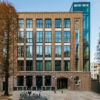231,000 litres of water flow past the village of Oberriet every second. We wouldn’t
even begin to try to work out how much that would add up since Jansen was first
founded here in 1923 – let’s just say it’s an inconceivable amount. Jansen’s location
in the St. Gallen Rhine Valley was no accident. Not only does it offer excellent access
to the road, rail and waterway network, but it also allowed us to establish a connection
to the Swiss high-pressure natural gas transport network at a very early stage.
Having a reliable supply of energy is an essential competitive factor for a company
that develops, manufactures and sells steel profile systems . Another thing that goes a
long way towards achieving success on the international market is offering products
that are just ahead of their time. This was the case with the first fully insulated steel
profile system for building façades, which Jansen patented in 1969 under the name
“VISS”. Not long after, the world was hit with the first-ever oil crisis, which led to a
major re-think of the energy consumption of buildings. And thanks to Jansen’s large
steel and glass façades, the new demand for improved thermal insulation could be
met. History repeated itself recently, with Jansen having a similarly successful product
launch with its new Janisol Arte system. This highly heat-insulating steel profile
system for restoring intricate industrial and fixed glazing came onto the market at
exactly the same time as the sustainable renovation of old buildings was enjoying increased
popularity.
“Panta rhei” – everything flows. The famous words of Heraclitus ring true at Jansen's headquarters in eastern Switzerland, and not just due to its proximity to the River Rhine.
Just as social requirements change, so too must companies. After all, if you don’t
keep up with the times, they will leave you behind. The future of Jansen will be determined
by its approach to sustainability, digitalisation and security. In recent years,
the issue of security in particular has become increasingly prevalent in construction
planning. This issue of SCALE gives an impressive demonstration of how the
heavy-duty steel profile systems from Jansen can be used to implement robust constructions
that meet even the strictest security requirements. With planning becoming
increasingly digital, the company also has its own BIM competence centre, which
supports architects and planners from the first click to the finished façade.
Façades
made of steel profiles are particularly sustainable. When combined with high-quality
functional glass, they are guaranteed to meet the necessary requirements for decades
to come, and at comparatively low maintenance costs. What’s more: steel profiles are
100% recyclable – a key factor when assessing the building standard according to
Leadership in Energy and Environmental Design (LEED), the German Sustainable
Building Council (DGNB), Building Research Establishment Environmental Assessment
Methodology (BREEAM) and, last but not least, the Swiss Sustainable Building
Standard (SNBS).

